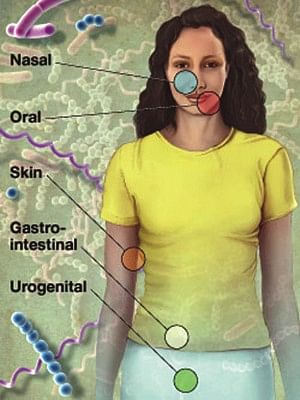Microbes that live on us

How independent am I or are you? Even grown as adults and educated as 'learned', can you decide your lifestyle by yourself (including spouse, of course!)? Most likely your answer is yes. That mindset may need some adjustment in the near future even for the strongest dictator on earth! Some indications at least appear to be leading us into that direction.
In your empty room environment, you are not alone. There are a hundred thousand crore more lives. Don't get scared, they are not Jins or bhuts the unhappy souls of the dead. They may not have hearts and minds but they can be kind or cruel depending on how you treat them. They are living in and on you. They are mostly bacteria living inside your mouth, nose, stomach, armpit, feet, genital, skin, you name it. And they are talking (communicating) with you all the time, so you may feel taking a shower to lessen your etching and scratching, or an antibiotic to cure a stomach ache. The collective community of human microbes (bacteria, yeast, etc. which we cannot see without a microscope) is called Human Microbiome.
Under ideal conditions, a child will emerge from a mother's womb alone. Once in the outside hostile environment, hundreds of different types of microbes silently start to colonize us and derive food from the body. In return, many of them are making and constantly supplying us with essential vitamins and other nutrients. To appreciate the importance of this symbiotic (inter dependent), opportunistic or parasitic relationship, scientists in the USA and elsewhere have started to catalogue these bacteria five years hence. This was possible due to a newly developed discipline called metagenomics. The US consortium of scientists has determined the genomes (complete genetic information) of 178 reference (typical) bacteria of the human body. Their goal is 1000. Guess who is leading this consortium. Who else other than the Institute founded by Craig J. Venter, the scientist who completed the Human Genome Project at an unprecedented speed! (I pass this institute at least twice during daily commute to and from work). It is this same Craig Venter who shook the world this last week by reporting to have created the first life in his laboratory (Daily Star, May 21, 2010). A mind boggling personality indeed!
What these scientists accomplished even from such a small number of human bacteria is amazing. They identified 30,000 genes (blueprint information) for unique proteins of which a few had novel gene functions. Their results were published in the journal, Science on May 21 this year. These novel functions can have far reaching implications to our understanding of how our body works. For example, could some aspect of our metabolic activity be the result of metabolic influence of these opportunistic bacteria? Another consortium of scientists spanning 4 continents catalogued 3.3 million genes of >1000 intestinal bacteria (Intestinal Microbiome) from 174 healthy individuals. This pool of genes is more than 150 times larger than the Human Genome (Nature, March 04, 2010).
One can only imagine how much influence these microbes could have on our lives daily and for the whole life. We have to wait some more years for an answer. But next time I would like to poke your imagination by asking if we could tame the terrorists and eve teasers by antibiotic treatment.

 For all latest news, follow The Daily Star's Google News channel.
For all latest news, follow The Daily Star's Google News channel. 



Comments